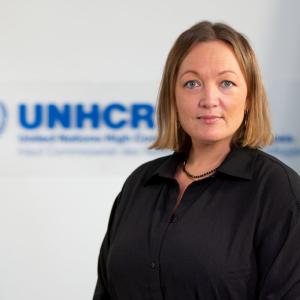Ahead of the 4th Ukraine Recovery Conference, UNHCR shares new forecasting model and policy brief on future returns of Ukrainian refugees
09 July 2025
Today, UNHCR, the UN Refugee Agency, and Brunel University of London released initial forecasts of future returns of Ukrainian refugees based on an innovative modelling prototype. The forecasts and an accompanying policy brief highlight the potential of this approach to aid an equitable national recovery effort inside Ukraine by informing priorities and programmes based on anticipated needs of the returning population.
The jointly developed prototype builds on UNHCR’s six rounds of refugee intentions surveys, undertaken since 2022 in partnership with IPSOS. The surveys have provided a broad range of representative demographic and household-level information on people who have fled Ukraine since February 2022 because of Russia’s full-scale invasion.
The forecasting modelling – which also factors in publicly available data and relevant analyses to weigh various factors and sensitivities on decision-making – illustrates the significant variations and complexities that may characterize future return patterns under different hypothetical scenarios.
In broad terms the modelling forecasts certain outcomes across all scenarios: Proportionally, older people, those with fewer family responsibilities, and those who own intact property in Ukraine are more likely to return. In contrast, youth, families with children, and those who have found jobs in host countries are less likely to return according to the forecasts. Moreover, the modelling suggests that returns will not be evenly distributed across refugees’ regions of origin, and many people may opt to return to different regions than they fled from.
With the war continuing, UNHCR is currently not facilitating or promoting returns to Ukraine. It is nevertheless imperative for all relevant stakeholders to prepare for the day when larger numbers of Ukrainian refugees may choose to return.
“No forecasting model can serve as a ‘crystal ball’, but scientific models such as this one can help us understand potential return patterns and be an invaluable planning tool,” noted UNHCR Regional Director for Europe, Philippe Leclerc. “The forecasts will help inform policies and programmes – of governments, financial institutions and development actors as well as the private sector – and working jointly, we can create the conditions for a more efficient national recovery that leaves no one behind. We hope the prototype results can feed constructively into the discussions at the recovery conference in Rome this week and beyond.”
The fourth Ukraine Recovery Conference, organized by the Governments of Ukraine and Italy, is taking place in Rome on 10-11 July with the participation of the UN High Commissioner for Refugees, Filippo Grandi.
The prototype has been developed over 18 months under guidance from an expert advisory board with representatives from the World Bank, International Monetary Fund, European Bank for Reconstruction and Development (EBRD), United Kingdom’s Foreign, Commonweath and Development Office (FCDO), Organization for Economic Cooperation and Development (OECD), EU institutions, Ukraine’s Ministry of Economy and the Kyiv School of Economics.
For more information, please contact:
In Ukraine: Elisabeth Arnsdorf Haslund haslund@unhcr.org, +380 95 239 0072
In Geneva: Eleni Biza, biza@unhcr.org, +41 78 337 8082



